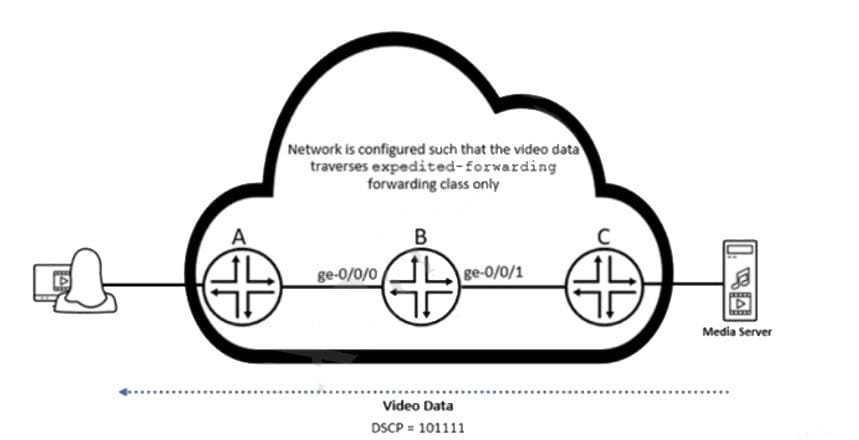Exam Details
Exam Code
:JN0-649Exam Name
:Enterprise Routing and Switching, Professional (JNCIP-ENT)Certification
:Juniper CertificationsVendor
:JuniperTotal Questions
:65 Q&AsLast Updated
:Jul 29, 2025
Juniper Juniper Certifications JN0-649 Questions & Answers
-
Question 21:
The connection between DC1 and DC2 is routed as shown in the exhibit. In this scenario, which statement is correct?

A. The border devices must be able to perform Layer 3 routing and provide IRB functionality.
B. L3VPN must be enabled to advertise reachability.
C. An IP prefix route provides encoding for intra-subnet forwarding.
D. Type 2 and Type 5 routes will be exchanged between DC1 and DC2.
-
Question 22:
You are asked to establish interface level authentication for users connecting to your network. You must ensure that only corporate devices, identified by MAC addresses, are allowed to connect and authenticate. Authentication must be handled by a centralized server to increase scalability.
Which authentication method would satisfy this requirement?
A. MAC RADIUS
B. captive portal
C. 802.1X with single-secure supplicant mode
D. 802.1X with multiple supplicant mode
-
Question 23:
When using wide metrics, which two statements about route advertisement between IS-IS levels are correct? (Choose two.)
A. Level 1 and Level 2 routers do not advertise Level 2 routes into the Level 1 area by default.
B. Level 1 routes are advertised to Level 2 routers by default.
C. If wide-metrics-only is configured, Level 1 routes are not advertised to Level 2 routers by default.
D. Level 1 routes advertised as external routes into Level 1 are not advertised to any Level 2 routers by default.
-
Question 24:
Which two statements are correct about the deployment of EVPN-VXLAN on QFX Series devices? (Choose two.)
A. Type 1 routeadvertisements always have the single-active flag set to 1.
B. Junos OS supports underlay replication for BUM traffic forwarding.
C. Junos OS supports ingress replication for BUM traffic forwarding.
D. Type 1 route advertisements always have thesingle-active flag set to 0.
-
Question 25:
A Layer 2 connection does not expend across data centers. The IP subnet in a Layer 2 domain is confined within a single data center. Which EVPN route type is used to communicate prefixes between the data centers?
A. Type 1
B. Type 2
C. Type 4
D. Type 5
-
Question 26:
You have scheduled maintenance operationsfor one of the devices in your OSPF network. Referring to the exhibit, which three statements are correct? (Choose three.)

A. R1 does not participate in OSPF routing.
B. Any traffic destined for networks that terminate on R1 will still beforwarded to R1.
C. The metrics for all transit interfaces on R1 is set to the maximum value of 65,535.
D. R1 participates in OSPF routing but does not send or receive transit traffic.
E. R1 does not send or receive transit traffic during the maintenance window even if no alternative paths exist to the given destination.
-
Question 27:
You are asked to implement fault tolerant RPs in your multicast network. Which two solutions would accomplish this behavior? (Choose two.)
A. Use BFD with statically defined RPs.
B. Use MSDP withstatically defined RPs.
C. Use anycast PIM with statically defined RPs.
D. Use IGMPv3 with statically defined RPs.
-
Question 28:
A user is attempting to watch a high-definition video being streamed from the mediaserver over the network. However, the user complains that the experienced video quality is poor. While logged on to router B, a Juniper Networks device, you notice that video packets are being dropped.
In this scenario, what would solve this problem?

A. Adjust the scheduler for the expedited-forwarding forwarding class to support a higher transmit rate.
B. Adjust the expedited-forwarding BA classifier to router B's ge-0/0/0 interface to support a higher transmit rate.
C. Adjust thescheduler-map to support a higher transmit rate.
D. Adjust the expedited-forwarding BA classifier on router B's ge-0/0/1 interface to support a higher transmit rate.
-
Question 29:
You must provide network connectivity to hosts that fail authentication.
In this scenario, what would be used in a network secured with 802.1X to satisfy this requirement?
A. Configure the native-vlan-id parameter on the port.
B. Use the server-reject-vlan command to specify a guest VLAN.
C. Configure a secondary IP address on the port for unauthenticated hosts.
D. Configure the port as a spanning tree edge port.
-
Question 30:
In OSPF, how does a router ensure that LSAs advertised to a neighboring router are received?
A. LSA flooding guarantees that all routers will receive them successfully.
B. LSAs are sent over a TCP connection.
C. LSAs are acknowledged by the neighboring router.
D. LSAs are advertised with an acknowledgement bit.
Related Exams:
JN0-102
Internet Associate, Junos(JNCIA-Junos)JN0-104
Junos, Associate (JNCIA-Junos)JN0-105
Junos, Associate (JNCIA-Junos)JN0-1101
Juniper Networks Certified Design Associate (JNCDA)JN0-1103
Design, Associate (JNCIA-Design)JN0-130
Juniper networks Certified internet specialist.e(jncis-e)JN0-1301
Data Center Design, Specialist (JNCDS-DC)JN0-1302
Data Center Design Specialist (JNCDS-DC)JN0-1331
Security Design, Specialist (JNCDS-SEC)JN0-1332
Security Design, Specialist (JNCDS-SEC)
Tips on How to Prepare for the Exams
Nowadays, the certification exams become more and more important and required by more and more enterprises when applying for a job. But how to prepare for the exam effectively? How to prepare for the exam in a short time with less efforts? How to get a ideal result and how to find the most reliable resources? Here on Vcedump.com, you will find all the answers. Vcedump.com provide not only Juniper exam questions, answers and explanations but also complete assistance on your exam preparation and certification application. If you are confused on your JN0-649 exam preparations and Juniper certification application, do not hesitate to visit our Vcedump.com to find your solutions here.